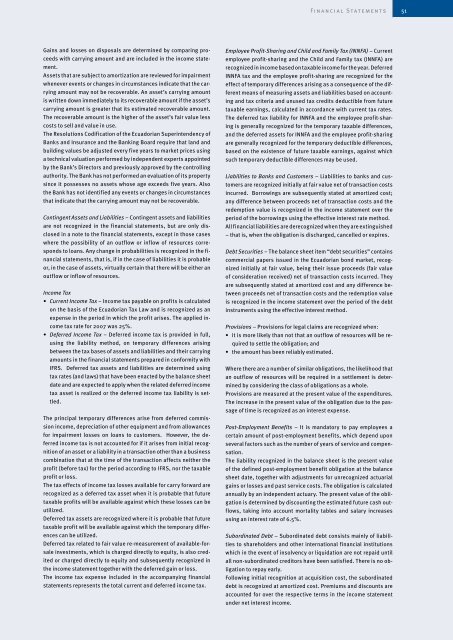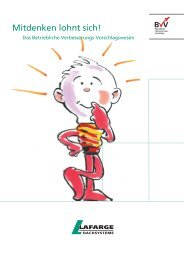Annual Report 2007
Annual Report 2007
Annual Report 2007
Create successful ePaper yourself
Turn your PDF publications into a flip-book with our unique Google optimized e-Paper software.
Gains and losses on disposals are determined by comparing proceeds<br />
with carrying amount and are included in the income statement.<br />
Assets that are subject to amortization are reviewed for impairment<br />
whenever events or changes in circumstances indicate that the carrying<br />
amount may not be recoverable. An asset’s carrying amount<br />
is written down immediately to its recoverable amount if the asset’s<br />
carrying amount is greater that its estimated recoverable amount.<br />
The recoverable amount is the higher of the asset’s fair value less<br />
costs to sell and value in use.<br />
The Resolutions Codification of the Ecuadorian Superintendency of<br />
Banks and Insurance and the Banking Board require that land and<br />
building values be adjusted every five years to market prices using<br />
a technical valuation performed by independent experts appointed<br />
by the Bank’s Directors and previously approved by the controlling<br />
authority. The Bank has not performed an evaluation of its property<br />
since it possesses no assets whose age exceeds five years. Also<br />
the Bank has not identified any events or changes in circumstances<br />
that indicate that the carrying amount may not be recoverable.<br />
Contingent Assets and Liabilities – Contingent assets and liabilities<br />
are not recognized in the financial statements, but are only disclosed<br />
in a note to the financial statements, except in those cases<br />
where the possibility of an outflow or inflow of resources corresponds<br />
to loans. Any change in probabilities is recognized in the financial<br />
statements, that is, if in the case of liabilities it is probable<br />
or, in the case of assets, virtually certain that there will be either an<br />
outflow or inflow of resources.<br />
Income Tax<br />
• Current Income Tax – Income tax payable on profits is calculated<br />
on the basis of the Ecuadorian Tax Law and is recognized as an<br />
expense in the period in which the profit arises. The applied income<br />
tax rate for <strong>2007</strong> was 25%.<br />
• Deferred Income Tax – Deferred income tax is provided in full,<br />
using the liability method, on temporary differences arising<br />
between the tax bases of assets and liabilities and their carrying<br />
amounts in the financial statements prepared in conformity with<br />
IFRS. Deferred tax assets and liabilities are determined using<br />
tax rates (and laws) that have been enacted by the balance sheet<br />
date and are expected to apply when the related deferred income<br />
tax asset is realized or the deferred income tax liability is settled.<br />
The principal temporary differences arise from deferred commission<br />
income, depreciation of other equipment and from allowances<br />
for impairment losses on loans to customers. However, the deferred<br />
income tax is not accounted for if it arises from initial recognition<br />
of an asset or a liability in a transaction other than a business<br />
combination that at the time of the transaction affects neither the<br />
profit (before tax) for the period according to IFRS, nor the taxable<br />
profit or loss.<br />
The tax effects of income tax losses available for carry forward are<br />
recognized as a deferred tax asset when it is probable that future<br />
taxable profits will be available against which these losses can be<br />
utilized.<br />
Deferred tax assets are recognized where it is probable that future<br />
taxable profit will be available against which the temporary differences<br />
can be utilized.<br />
Deferred tax related to fair value re-measurement of available-forsale<br />
investments, which is charged directly to equity, is also credited<br />
or charged directly to equity and subsequently recognized in<br />
the income statement together with the deferred gain or loss.<br />
The income tax expense included in the accompanying financial<br />
statements represents the total current and deferred income tax.<br />
F i n a n c i a l S tat e m e n t s 1<br />
Employee Profit-Sharing and Child and Family Tax (INNFA) – Current<br />
employee profit-sharing and the Child and Family tax (INNFA) are<br />
recognized in income based on taxable income for the year. Deferred<br />
INNFA tax and the employee profit-sharing are recognized for the<br />
effect of temporary differences arising as a consequence of the different<br />
means of measuring assets and liabilities based on accounting<br />
and tax criteria and unused tax credits deductible from future<br />
taxable earnings, calculated in accordance with current tax rates.<br />
The deferred tax liability for INNFA and the employee profit-sharing<br />
is generally recognized for the temporary taxable differences,<br />
and the deferred assets for INNFA and the employee profit-sharing<br />
are generally recognized for the temporary deductible differences,<br />
based on the existence of future taxable earnings, against which<br />
such temporary deductible differences may be used.<br />
Liabilities to Banks and Customers – Liabilities to banks and customers<br />
are recognized initially at fair value net of transaction costs<br />
incurred. Borrowings are subsequently stated at amortized cost;<br />
any difference between proceeds net of transaction costs and the<br />
redemption value is recognized in the income statement over the<br />
period of the borrowings using the effective interest rate method.<br />
All financial liabilities are derecognized when they are extinguished<br />
– that is, when the obligation is discharged, cancelled or expires.<br />
Debt Securities – The balance sheet item “debt securities” contains<br />
commercial papers issued in the Ecuadorian bond market, recognized<br />
initially at fair value, being their issue proceeds (fair value<br />
of consideration received) net of transaction costs incurred. They<br />
are subsequently stated at amortized cost and any difference between<br />
proceeds net of transaction costs and the redemption value<br />
is recognized in the income statement over the period of the debt<br />
instruments using the effective interest method.<br />
Provisions – Provisions for legal claims are recognized when:<br />
• it is more likely than not that an outflow of resources will be required<br />
to settle the obligation; and<br />
• the amount has been reliably estimated.<br />
Where there are a number of similar obligations, the likelihood that<br />
an outflow of resources will be required in a settlement is determined<br />
by considering the class of obligations as a whole.<br />
Provisions are measured at the present value of the expenditures.<br />
The increase in the present value of the obligation due to the passage<br />
of time is recognized as an interest expense.<br />
Post-Employment Benefits – It is mandatory to pay employees a<br />
certain amount of post-employment benefits, which depend upon<br />
several factors such as the number of years of service and compensation.<br />
The liability recognized in the balance sheet is the present value<br />
of the defined post-employment benefit obligation at the balance<br />
sheet date, together with adjustments for unrecognized actuarial<br />
gains or losses and past service costs. The obligation is calculated<br />
annually by an independent actuary. The present value of the obligation<br />
is determined by discounting the estimated future cash outflows,<br />
taking into account mortality tables and salary increases<br />
using an interest rate of 6.5%.<br />
Subordinated Debt – Subordinated debt consists mainly of liabilities<br />
to shareholders and other international financial institutions<br />
which in the event of insolvency or liquidation are not repaid until<br />
all non-subordinated creditors have been satisfied. There is no obligation<br />
to repay early.<br />
Following initial recognition at acquisition cost, the subordinated<br />
debt is recognized at amortized cost. Premiums and discounts are<br />
accounted for over the respective terms in the income statement<br />
under net interest income.
















